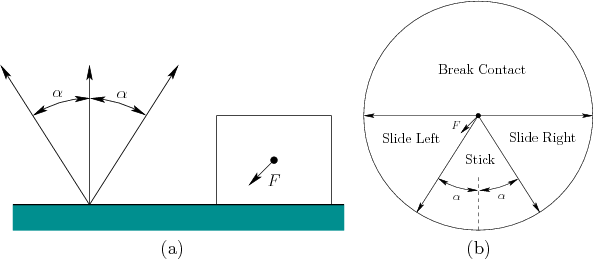
Next: Sources of uncertainty Up: 12.5.1 Preimage Planning Previous: 12.5.1 Preimage Planning
It will be seen shortly that the possibility of executing
compliant motions is crucial for reducing uncertainty in the
robot position. Let
![]() denote the obstacle boundary,
denote the obstacle boundary,
![]() (also,
(also,
![]() ). A model of robot motion
while
). A model of robot motion
while
![]() needs to be formulated. In general, this is
complicated by friction. A simple Coulomb friction model is
assumed here; see [681] for more details on modeling friction
in the context of manipulation planning. Suppose that the net force
needs to be formulated. In general, this is
complicated by friction. A simple Coulomb friction model is
assumed here; see [681] for more details on modeling friction
in the context of manipulation planning. Suppose that the net force
![]() is applied by a robot at some
is applied by a robot at some
![]() . The force could be
maintained by using the generalized damper model of robot
control [966].
. The force could be
maintained by using the generalized damper model of robot
control [966].
The resulting motion is characterized using a friction cone, as
shown in Figure 12.44a. A basic principle of Newtonian
mechanics is that the obstacle applies a reaction force (it may be
helpful to look ahead to Section 13.3, which introduces
mechanics). If ![]() points into the surface and is normal to it, then
the reaction force provided by the obstacle will cancel
points into the surface and is normal to it, then
the reaction force provided by the obstacle will cancel ![]() , and there
will be no motion. If
, and there
will be no motion. If ![]() is not perpendicular to the surface, then
sliding may occur. At one extreme,
is not perpendicular to the surface, then
sliding may occur. At one extreme, ![]() may be parallel to the
surface. In this case, it must slide along the boundary. In general,
may be parallel to the
surface. In this case, it must slide along the boundary. In general,
![]() can be decomposed into parallel and perpendicular components. If
the parallel component is too small relative to the perpendicular
component, then the robot becomes stuck. The friction cone shown in
Figure 12.44a indicates precisely the conditions under
which motion occurs. The parameter
can be decomposed into parallel and perpendicular components. If
the parallel component is too small relative to the perpendicular
component, then the robot becomes stuck. The friction cone shown in
Figure 12.44a indicates precisely the conditions under
which motion occurs. The parameter ![]() captures the amount of
friction (more friction leads to larger
captures the amount of
friction (more friction leads to larger ![]() ). Figure
12.44b indicates the behaviors that occur for various
directions of
). Figure
12.44b indicates the behaviors that occur for various
directions of ![]() . The diagram is obtained by inverting the friction
cone. If
. The diagram is obtained by inverting the friction
cone. If ![]() points into the bottom region, then sticking
occurs, which means that the robot cannot move. If
points into the bottom region, then sticking
occurs, which means that the robot cannot move. If ![]() points away
from the obstacle boundary, then contact is broken (this is
reasonable, unless the boundary is sticky). For the remaining two
cases, the robot slides along the boundary.
points away
from the obstacle boundary, then contact is broken (this is
reasonable, unless the boundary is sticky). For the remaining two
cases, the robot slides along the boundary.
 |
Steven M LaValle 2012-04-20